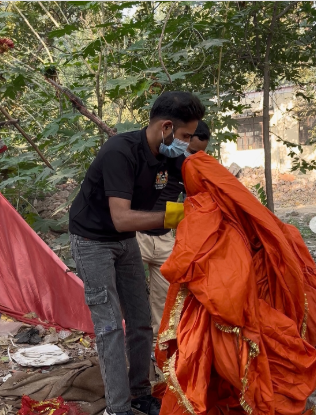The streets, rivers and public spaces of Bareilly are witnessing a vibrant new chapter of environmental stewardship, driven by the city’s youth through the #CleanupBhai campaign.
This youth-led initiative, gaining momentum on social media and in communities, calls for a collective commitment to restoring Bareilly’s natural beauty and ecological health.
With support from local authorities including Chief Minister Yogi Adityanath, the campaign blends grassroots enthusiasm with technology-enabled mapping to tackle longstanding pollution and waste disposal challenges affecting the Ramganga river and public spaces across the city.

Young Voices Rally for a Greener Future
What began as a passionate social media campaign has blossomed into a city-wide movement captivating hundreds of young volunteers, students, local NGOs and concerned residents who believe in a cleaner, greener Bareilly.
“Every living being, every place, every river is calling out to us,” reads the campaign slogan, shared widely under the hashtags #CleanupBhai and #ExplorePage.
The initiative mobilises youth leadership and community participation, with volunteers organizing riverbank clean-ups, awareness drives, and waste segregations in public parks.
Their efforts are supported by satellite imagery and drone technology furnished by the municipal corporation to identify the worst-affected pollution hotspots and illegal waste dumping sites.
Satyendra Verma, Bareilly Municipal Commissioner, emphasises the crucial role of young people in this environmental revival: “Our youth are not just our future but our present. Their energy and commitment catalyse change that administration alone cannot achieve.”
Through coordinated clean-up bus tours and interactive workshops, the campaign nurtures environmental education alongside urgent action. Residents express renewed hope that these efforts will restore Bareilly’s rivers and parks not only as ecological treasures but as shared community spaces.

Challenges in Bareilly’s Waste Management
Bareilly, like many growing urban centres in India, grapples with complex waste management issues. The city generates significant municipal solid waste, and reports indicate that waste disposal systems have struggled under the pressure of urban expansion.
In some parts of the city, such as the Umang Part-2 colony, citizens complain about chronic garbage accumulation and open burning of waste, which harms both local ecosystems and public health.
Despite annual revenue collections devoted to waste management-estimated at around ₹1.34 crore in some reports-proper treatment and disposal remain critical concerns.
The #CleanupBhai campaign contextualises these challenges within a larger environmental crisis, urging sustainable practices over mere band-aid fixes. It champions people-powered solutions that bring governmental efforts, technology, and citizen vigilance together for long-term impact.
Officials confirm increased surveillance and enforcement actions to curb illegal dumping and boost river cleanliness, with the campaign spotlighting areas that require immediate focus.
Experts laud this approach for turning passive citizens into active environmental guardians, thereby laying the foundation for ongoing stewardship rather than intermittent clean-ups.

A Model for India’s Cities: Participatory Environmental Governance
The Bareilly initiative reflects a growing trend in Indian cities where civic action complements government policies aimed at sustainable urban development. In recent years, Uttar Pradesh has stepped up environmental programmes, integrating heritage conservation with pollution control along rivers and green spaces.
However, the success of such initiatives often hinges on community engagement, transparency, and accountability-elements that #CleanupBhai actively promotes.
By leveraging social media to create awareness and employing satellite technology for targeted interventions, #CleanupBhai exemplifies the power of collaborative, tech-savvy, youth-led environmentalism.
This campaign also underscores how caring for urban nature can heal social divisions, fostering unity in diversity through shared responsibility for common spaces.
It encourages a cultural shift towards valuing nature not just as a resource but as an integral part of community identity and wellbeing.
The Logical Indian’s Perspective
The Logical Indian celebrates the #CleanupBhai movement as a beacon of hope and a blueprint for urban ecological regeneration rooted in empathy and proactive citizenship.
Our cities face complex environmental challenges that require more than government mandates-they demand collective care, sustained dialogue, and kindness towards all beings sharing these spaces.
The Bareilly youth’s call to action resonates with our belief that social transformation begins when individuals see themselves not as separate from nature but as its custodians.
The campaign invites all Indians to imagine their rivers, parks, and neighbourhoods as ecosystems worth protecting through daily acts of care and respect.









